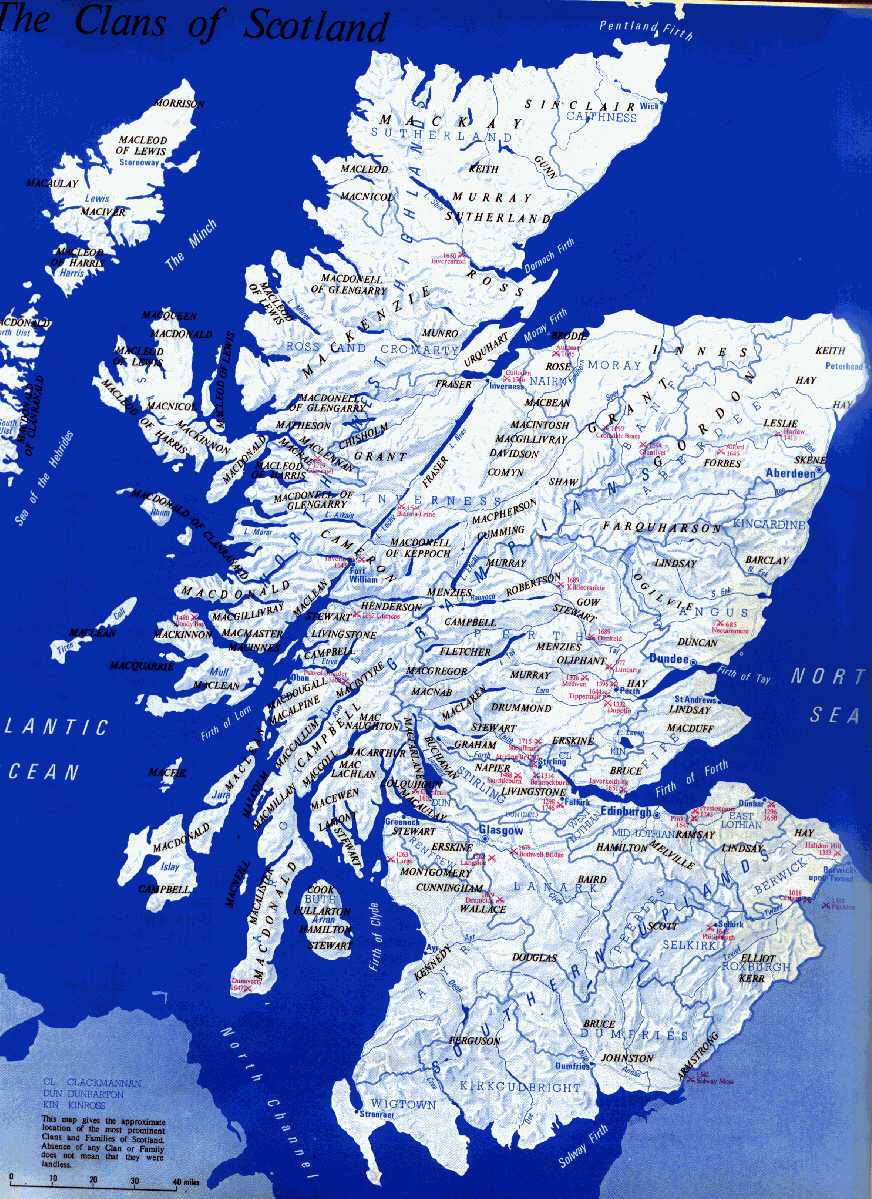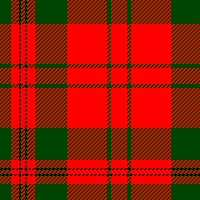Origin of the Name
One source says the family is descended from a Saxon named "Leving"
or "Leuing". His son was Turstanus Filius Leving. Filius means "son
of". Turstanus settled in Scotland, Western Lothian with a charter
of lands granted to him by David I. He established his house as Leving
es toun. I am not sure of the spelling, but it basically means House
of Leving. So all of his descendants were known as "name" of or de
Leving es toun. Through the years the name became more Anglicised
and ultimately became Livingston and sometimes listed as Livingstone as
the English were always adding an "e" to the end of familes' names.
Now, there is also a Highland family by the name of Livingstone.
Just to make things a little more complicated. This had come about
around 1600's. This was when a Livingston of the Earlier family was
appointed Overlord of the Lismore and nearby Argyle region. The main
clans and families in the area were the MacDougalls, the Stewarts of Appin,
and some Campbells. There was a small family believed to be a sept
of the Stewarts of Appin, the MacLeays. It is believed that some
of the MacLeays wanted to gain more political clout and also to avoid siding
with any local clan by adopting the name of the new Overlord. They
then added an "e" to the end
of it to distinguish it from the other family.
Another source says Barney Barco writes about the history of the
Livingston clan in the introduction to The "Livingstons of Virginia", Volume
1, by Lucille Barco Coone. He includes this paragraph in his essay,
"Livingstons is an ancient name existing long before the twelfth century
when the name appears in early characters as Livingsten. This is
the anglicized version of the Gaelic "Mac-an Leigh" meaning "son of the
physician". The name first appears in Argyll and the descendants
of this clan claim to be descended from the physician of the Lord of the
Isles. The "Isles" could have been either the Inner or Outer Hebrides
and the "Lord" was probably the progenitor of either the MacLean, Macleod
or MacDonald clans. Clan Livingston was closely allied with the Campbells
of Argyll and later with the Stewarts. "
Place of Origin
Callendar House, an large ornate mansion of the 1870s with towers
and turrets, incorporates a 14th- or 15th-century castle. It was held by
the Livingstone family from 1345, who were made Earls of Callendar in 1641.
Mary, Queen of Scots, stayed here several times in the 1560s. The castle
was stormed and captured by Cromwell in 1650, and later used as his headquarters
by General Monck. The Livingstones were forfeited for their part in the
1715 Jacobite Rising, and Bonnie Prince Charlie stayed here in 1745.
Since the beginning of time, the Falkirk area has been a cross-roads
for travellers. In recognition of the area's strategic importance the Romans
built their Antonine Wall across the area, and the remains of the wall
can still be seen in the grounds of Callendar House. By the 11th century
the house of the King's representative, the Thane of Callendar, nestled
behind the ancient wall for protection and here the foundations were laid
for the creation of Callendar House.
The first stone building on the site was a tower house built in 1345
by William de Livingstone after he was gifted the estates of Callendar
by King David II. The house was occupied by the Livingstones and their
descendants until the death of Lady Anne in 1747. In 1783 the House and
the estate were put up for auction and although the Livingstone family
attempted to purchase the property, they were easily outbid by William
Forbes, a copper merchant from London and a "self made man".
In March 2000 Falkirk will celebrate the 400th anniversary of its
Burgh Charter, which was given by King James VI to the Livingstone family
of Callendar.
Map of Scotland Clans

The Livingstons, who had risen to eminence in James II's minority,
were not, like the Albanys, of the royal house, and, far from being competitors
for the crown, were not even of the highest rank amont the nobility. The
events through which such a family had established its ascendancy are obscure.
At first after James I's death, his widow, Queen Joan, was associated in
the administration with the fifth Earl of Douglas and Bishop Cameron of
Glasgow, who was chancellor; but in May 1439 Cameron was replaced as chancellor
by Sir William Crichton and in the following month Douglas died. Shortly
afterwards the Queen married Sir James Stewart of Lorne. This marriage
to a subject, and one not of the first rank, may have been thought to disqualify
the Queen from any further part in government, and if she and her husband
had any thought of seizing power, they were thwarted by Sir Alexander Livingston,
who arrested them and let them go only on condition that they were not
to retain custody of the young King. Livingston and Chancellor Crichton
for a time competed for the keeping of the King's person, then for a time
collaborated, but by 1445 Livingston had become the senior partner in the
alliance and Crichton was ousted from the chancellorship. By 1449 the Livingstons
were well entrenched in office. Sir Alexander was justiciar; Sir James
was chamberlain; Robert Livingston of Linlithgow was comptroller; John
Livingston was master of the mint; and the captains of the castles of Stirling,
Dumbarton, Doune and Methven were all Livingstons. They obviously had a
tight grip on government finance, they controlled much crown property,
and in Stirling and Dumbarton they held two of the castles which could
be reckoned among the keys of the kingdom.
Their fall was sudden and spectacular. On Monday, 23 September 1449,
we are told by a contemporary chronicler, 'James of Levingstoun was arrestit
be the King, and Robyn [Livintston of] Kalendar, capitane of Dunbertane,
and Johne of Levingstoun, capitane of the castell of Doune, and David Levingstoun
of the Greneyardis, with syndry uthiris. And sone after this, Schir Alexander
Levingstoun was arrestit, and Robyn of Levingstoun of Lithgow, that tyme
comptrollar. And James and his brother Alexander and Robyn of Lithgow war
put in the Blacknes, and thair gudis tane within xl dayis in all places,
and put under arrest, and all thair gudis that pertenit to that party.
And all officeris that war put in be thaim war clerlie put out of all officis,
and all put doun that thai put up. And this was a gret ferlie [marvel].'
[Ref: Auchinleck Chronicle, quoted A. I. Dunlop, Bishop Kennedy (1950,
106)] It was a change of government with a vengeance.
The circumstances of the Livingstons' fall are as obscure as those of
their rise to power. We do not know the grounds, either real or ostensible,
on which they were thus arrested and two of them put to death. But, as
had been the case with some of James I's actions, the reason for the proceedings
against the Livingstons may have been the inroads they had been making
on the resources of the crown. One of the Livingstons to be executed was
captain of Methven Castle, the other was custumar of Linlithgow: now, the
castle of Methven and the customs of Linlithgow were part of the marriage
portion of Mary of Gueldres, who had arrived in Scotland in June 1449 and
was married to James on 3 July, and, on the day after the Livingstons'
execution, parliament confirmed the marriage portion. It would seem that
it had been forcibly brought home to James that financially as otherwise
he was too much at the mercy of the Livingstons, and it may even be possible
to detect the hand of the new Queen, stimulating her husband to satisfy
her financial claims and at the same time assert his authority. Even so,
the overthrow of the Livingstons was thought so high-handed that some justification
was felt necessary, and a supplication to the pope stated that Livingston
of Callendar had been guilty of 'rebellion and other excesses'. Any tendency
to theorise about high principles on the part of the King and his advisers
may, besides, be checked when it is noted that James owed the Comptroller
the sum of 1,000 lbs. and that by the death and forfeiture of his creditor,
he was absolved from any need to repay the sum.
Possibly the greatest mystery is how a King of Scots, at the age of
eighteen, had the means to deal with a powerful family in such a sudden
and ruthless manner. But this is tied up with the question how the Livingstons
had themselves established their ascendancy and had ousted Crichton and
other competitors for office. It may be that the key is to be found in
the manoeuvrings of the great house of Douglas. There are certainly reasons
for believing that the eighth Earl of Douglas had helped to set Sir Alexander
Livingston up and that he may have decided in 1449 to pull him down; indeed,
the Douglases may all along have been the real power behind the Livingstons.
It was certainly the Douglases, and not the Livingstons or any other
lesser family, who constituted the significant threat to the crown in this
region.
http://www.houston-texas-online.com/livingston/index.html

